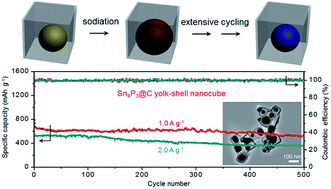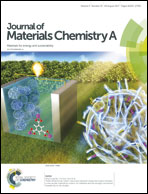Engineering tin phosphides@carbon yolk–shell nanocube structures as a highly stable anode material for sodium-ion batteries†
Abstract
Sodium-ion batteries (SIBs) are considered as promising alternatives to lithium-ion batteries because of the natural abundance and low cost of sodium resources. Unfortunately, SIBs usually suffer from the serious volume change of active materials and the sluggish kinetics of sodiation of the structure. To combat the above issues, herein we rationally design an integrated anode material of tin phosphides@carbon (Sn4P3@C) with a yolk–shell nanocube structure for SIBs. The voids and spaces between the Sn4P3 and carbon nanocubes can effective buffer the volume expansion of active materials during sodiation/desodiation processes, and the highly electrically conductive carbon material can promote the fast electron transfer, thus accelerating the kinetics of sodiation/desodiation. In SIBs, the Sn4P3@C yolk–shell nanocube electrode exhibits excellent sodium storage performance with a high discharge capacity of 701 mA h g−1 at 0.1 A g−1 after 50 cycles, remarkable rate capability (508 mA h g−1 even at 2.0 A g−1), and highly stable cycling performance (516 and 368 mA h g−1 after 500 cycles at 1.0 and 2.0 A g−1, respectively).



 Please wait while we load your content...
Please wait while we load your content...